Redux 背后的架构思想——认识 Flux 架构
Redux 的设计在很大程度上受益于 Flux 架构,我们可以认为 Redux 是 Flux 的一种实现形式(虽然它并不严格遵循 Flux 的设定),理解 Flux 将帮助你更好地从抽象层面把握 Redux。
Flux 并不是一个具体的框架,它是一套由 Facebook 技术团队提出的应用架构,这套架构约束的是应用处理数据的模式。在 Flux 架构中,一个应用将被拆分为以下 4 个部分。
- View(视图层):用户界面。该用户界面可以是以任何形式实现出来的,React 组件是一种形式,Vue、Angular 也完全 OK。Flux 架构与 React 之间并不存在耦合关系。
- Action(动作):也可以理解为视图层发出的“消息”,它会触发应用状态的改变。
- Dispatcher(派发器):它负责对 action 进行分发。
- Store(数据层):它是存储应用状态的“仓库”,此外还会定义修改状态的逻辑。store 的变化最终会映射到 view 层上去。
这 4 个部分之间的协作将通过下图所示的工作流规则来完成配合:
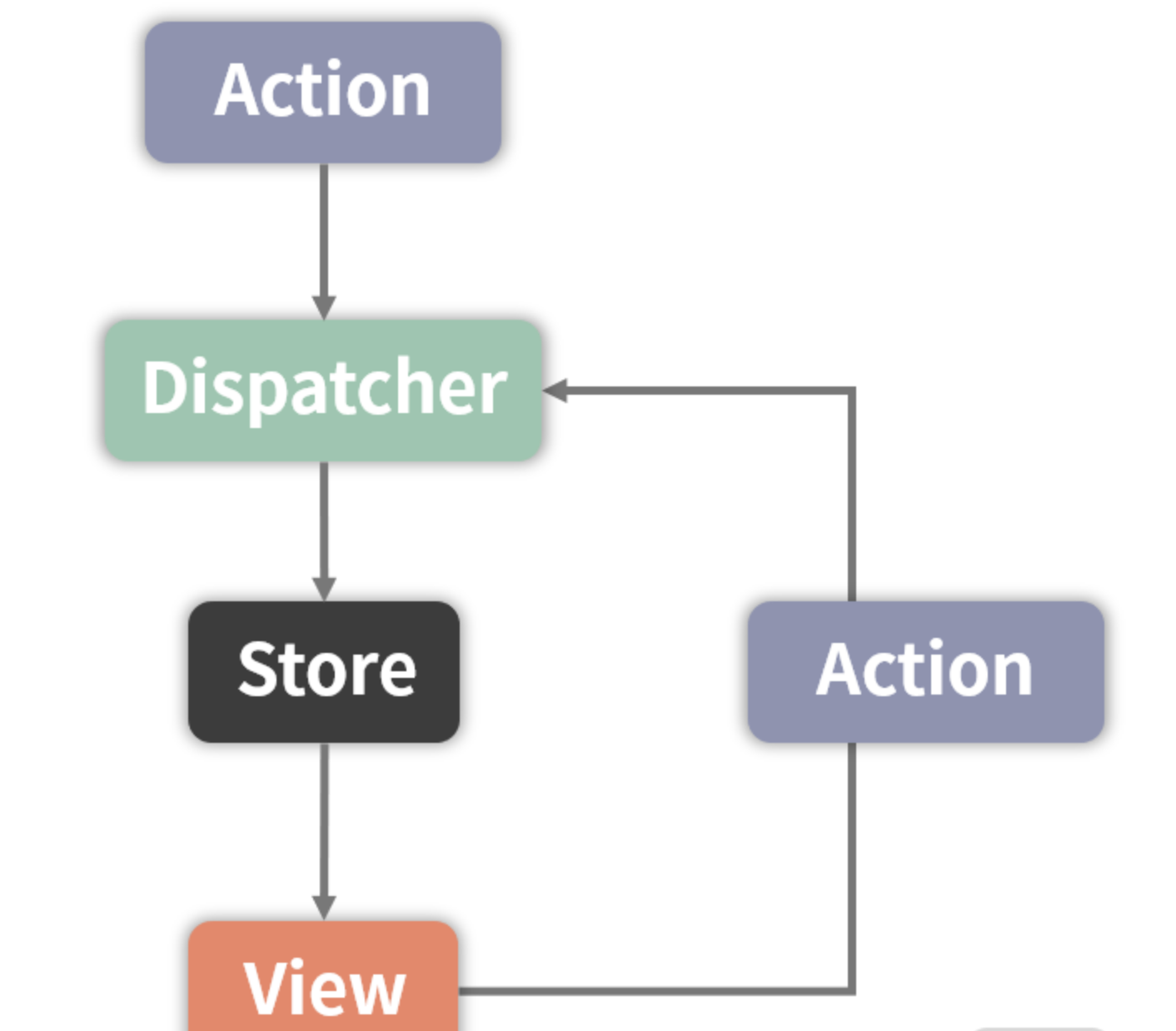
一个典型的 Flux 工作流是这样的:
用户与 View 之间产生交互,通过 View 发起一个 Action;Dispatcher 会把这个 Action 派发给 Store,通知 Store 进行相应的状态更新。Store 状态更新完成后,会进一步通知 View 去更新界面。
值得注意的是,图中所有的箭头都是单向的,这也正是 Flux 架构最核心的一个特点——单向数据流。
Flux 架构到底解决了什么问题
Flux 的核心特征是单向数据流,要想完全了解单向数据流的好处,我们需要先了解双向数据流带来了什么问题
MVC 模式在前端场景下的局限性
双向数据流最为典型的代表就是前端场景下的 MVC 架构,该架构的示意图如下图所示
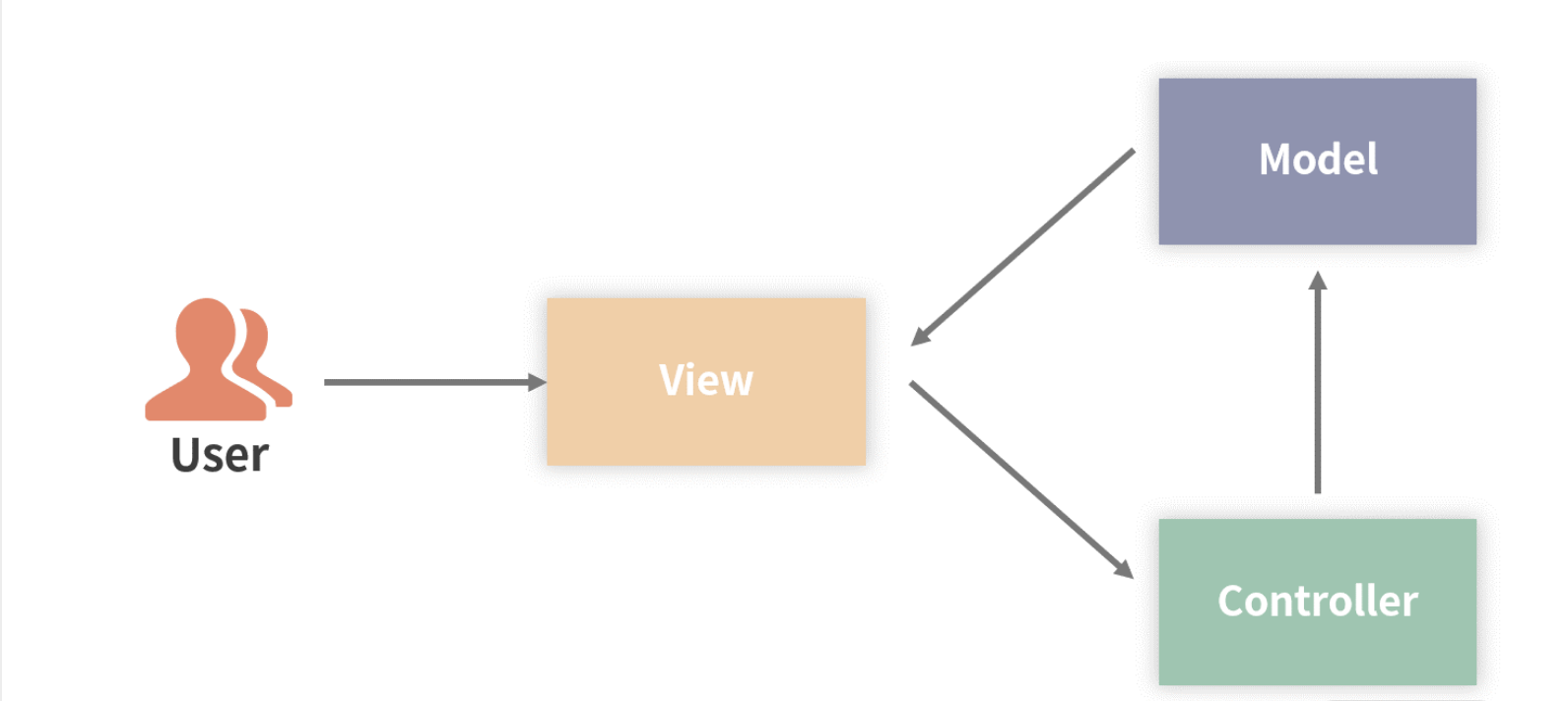
除了允许用户通过 View 层交互来触发流程以外,MVC 架构还有另外一种形式,即允许用户通过直接触发 Controller 逻辑来触发流程,这种模式下的架构关系如下图所示:
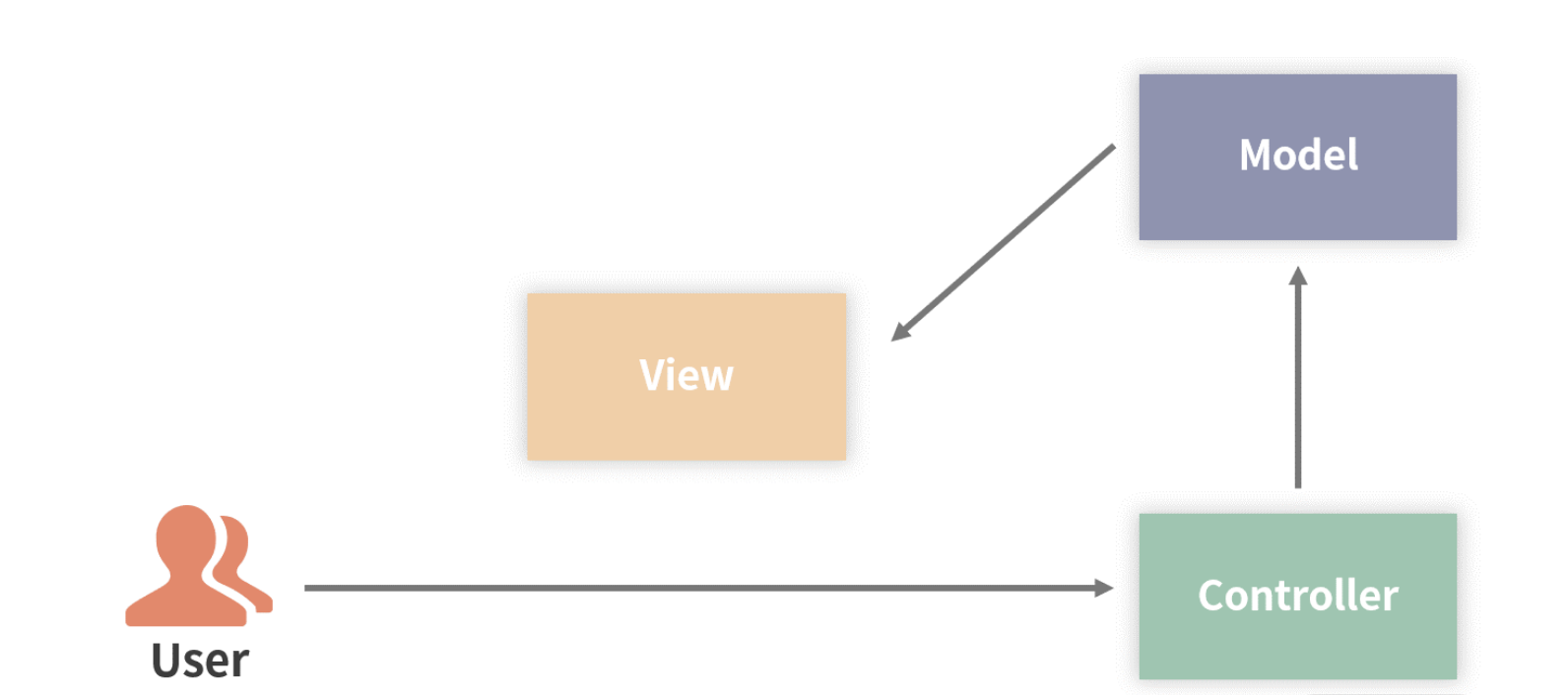
在 MVC 应用中,会涉及这 3 个部分:
Model(模型),程序需要操作的数据或信息;View(视图),用户界面;Controller(控制器),用于连接View和Model,管理Model与View之间的逻辑
原则上来说,三者的关系应该像上图一样,用户操作 View 后,由 Controller 来处理逻辑(或者直接触发 Controller 的逻辑),经过 Controller 将改变应用到 Model 中,最终再反馈到 View 上。在这个过程中,数据流应该是单向的。
事实上,在许多服务端的 MVC 应用中,数据流确实能够保持单向。但是在前端场景下,实际的 MVC 应用要复杂不少,前端应用/框架往往出于交互的需要,
允许 View 和 Model 直接通信。此时的架构关系就会变成下图这样:
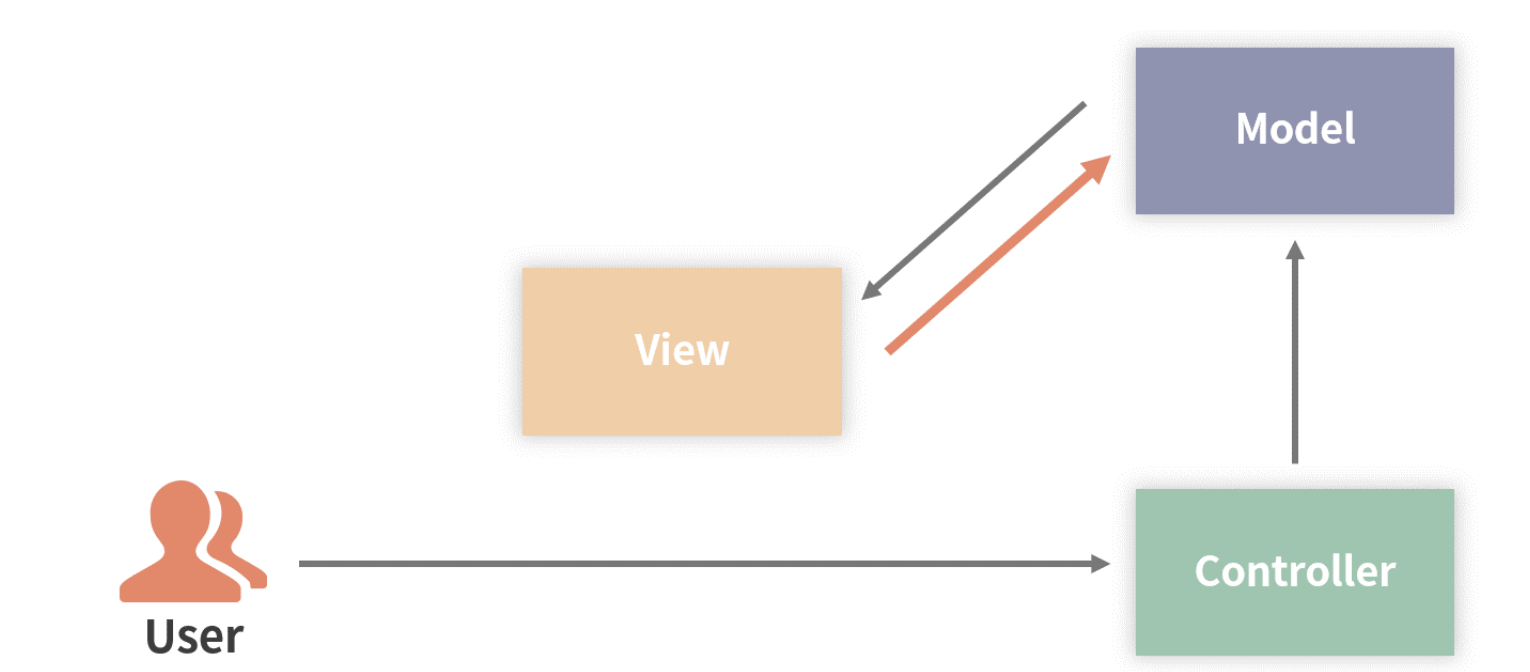
这就允许了双向数据流的存在。当业务复杂度较高时,数据流会变得非常混乱,出现类似下图这种情况:
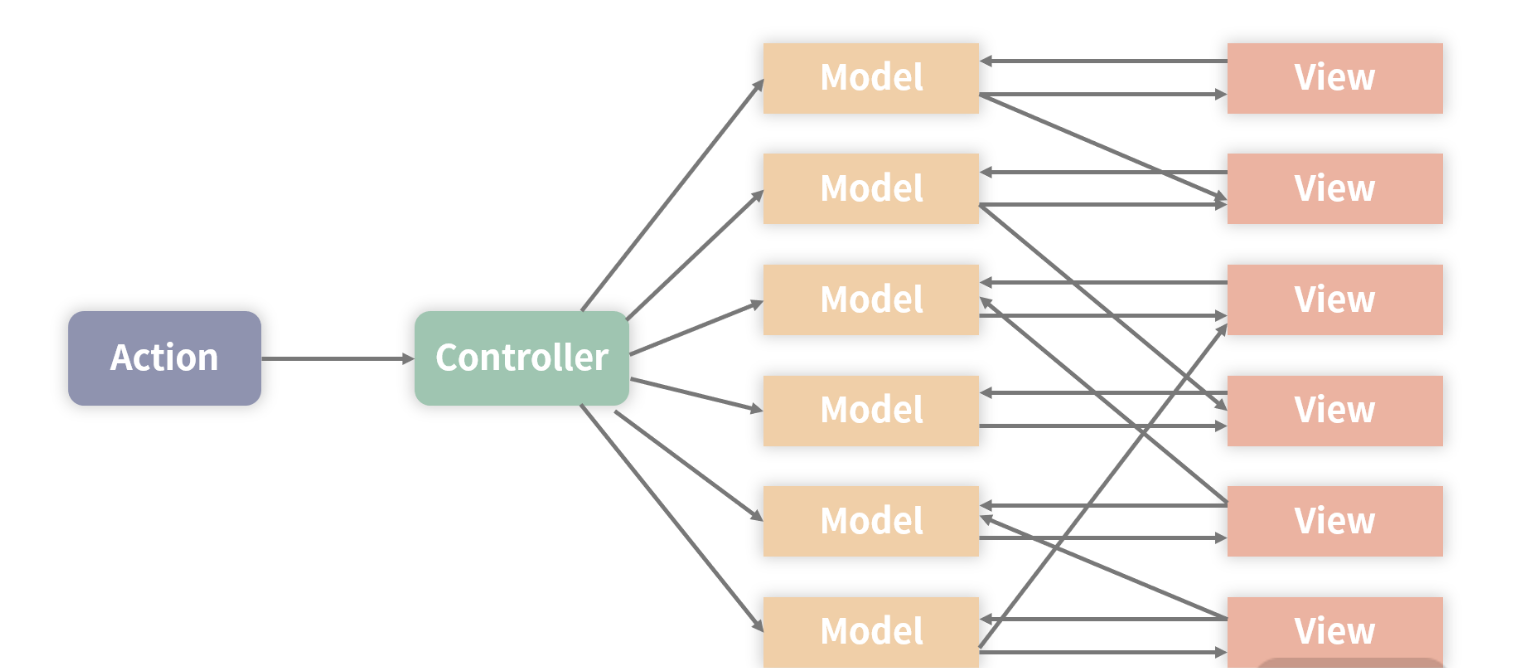
图中我们的示例只有一个 Controller,但考虑到一个应用中还可能存在多个 Controller,实际的情况应该比上图还要复杂得多
在如此复杂的依赖关系下,再小的项目变更也将伴随着不容小觑的风险——或许一个小小的改动,就会对整个项目造成“蝴蝶效应”般的巨大影响。如此混乱的修改来源,将会使得我们连 Bug 排查都无从下手,因为你很难区分出一个数据的变化到底是由哪个 Controller 或者哪个 View 引发的。
此时再回头看下 Flux 的架构模式,你应该多少能感受到其中的妙处。这里我们再来回顾一下 Flux 中的数据流模式,请看下图:
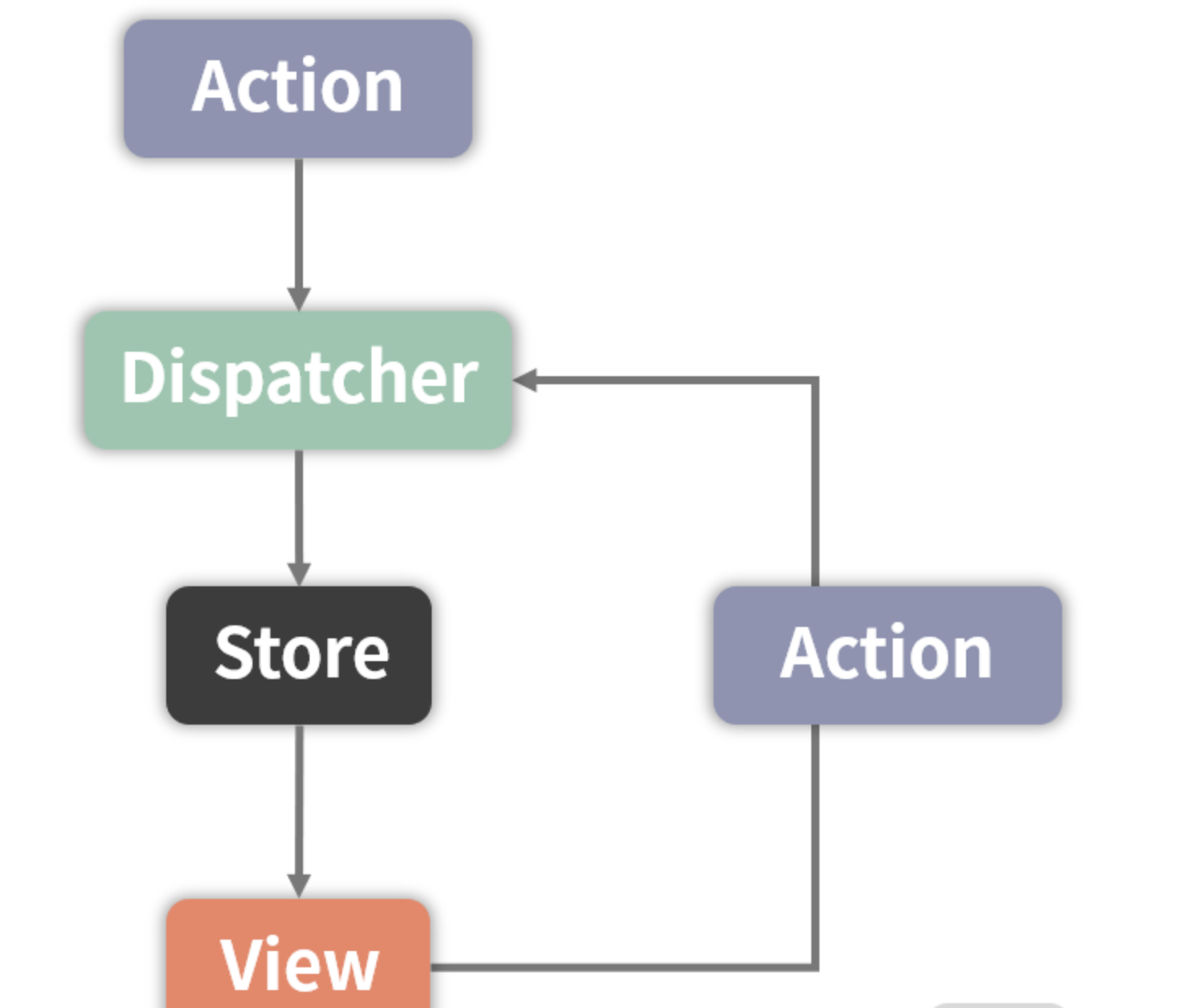
Flux 最核心的地方在于严格的单向数据流,在单向数据流下,状态的变化是可预测的。如果 store 中的数据发生了变化,那么有且仅有一个原因,那就是由 Dispatcher 派发 Action 来触发的。这样一来,就从根本上避免了混乱的数据关系,使整个流程变得清晰简单
不过这并不意味着 Flux 是完美的。事实上,Flux 对数据流的约束背后是不可忽视的成本:除了开发者的学习成本会提升外,Flux 架构还意味着项目中代码量的增加。
Flux 架构往往在复杂的项目中才会体现出它的优势和必要性。如果项目中的数据关系并不复杂,其实完全轮不到 Flux 登场,这一点对于 Redux 来说也是一样的。
现在你不妨结合 Flux 架构的特性,再去品味一遍 Redux 官方给出的这个定义:
Redux 是 JavaScript 状态容器,它提供可预测的状态管理。
此时的你,想必更加能够体会“可预测”这三个字背后的深意。
Redux 关键要素与工作流回顾
Redux 主要由 3 部分组成:
Store、Reducer 和 Action。
- Store:它是一个单一的数据源,而且是只读的。
- Action 人如其名,是“动作”的意思,它是对变化的描述。
- Reducer 是一个函数,它负责对变化进行分发和处理,最终将新的数据返回给 Store。
Store、Action 和 Reducer 三者紧密配合,便形成了 Redux 独树一帜的工作流,如下图所示:
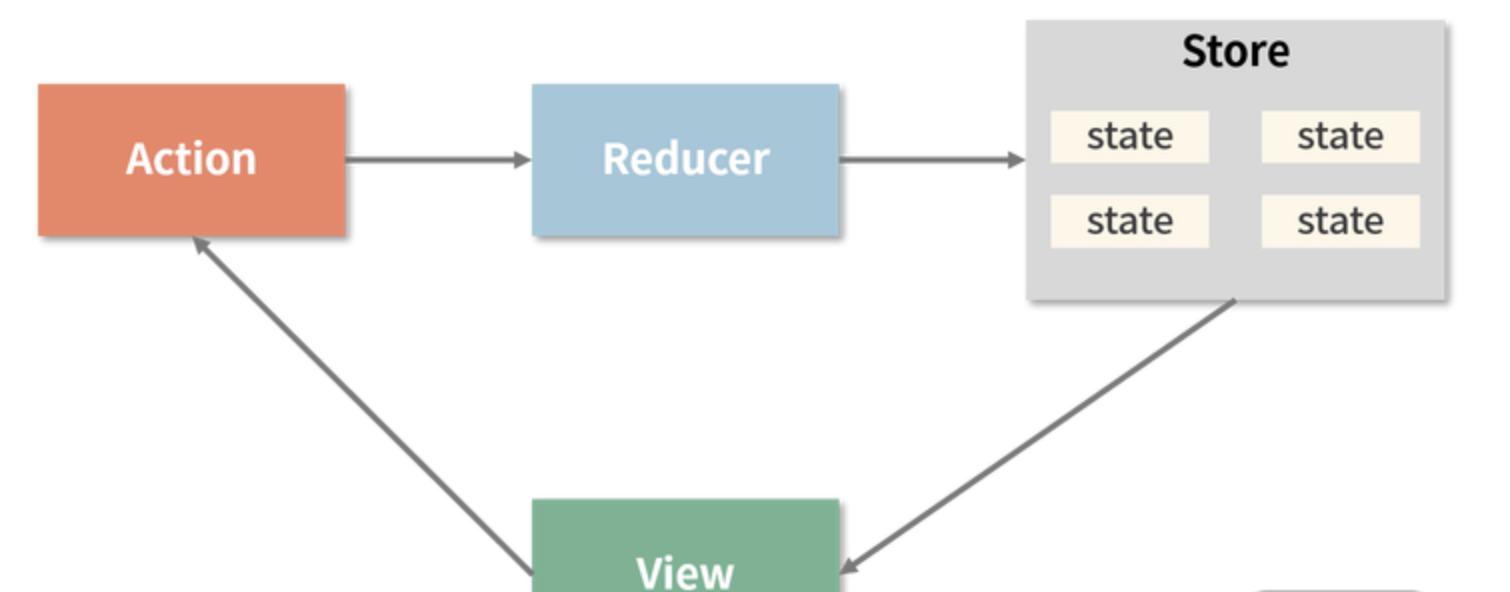
在 Redux 的整个工作过程中,数据流是严格单向的。如果你想对数据进行修改,只有一种途径:派发 Action。Action 会被 Reducer 读取,Reducer 将根据 Action 内容的不同执行不同的计算逻辑,最终生成新的 state(状态),这个新的 state 会更新到 Store 对象里,进而驱动视图层面作出对应的改变。
对于组件来说,任何组件都可以以约定的方式从 Store 读取到全局的状态,任何组件也都可以通过合理地派发 Action 来修改全局的状态。Redux 通过提供一个统一的状态容器,使得数据能够自由而有序地在任意组件之间穿梭。
Redux 是如何工作的
我们先来看一下 Redux 的源码文件夹结构,如下图所示:
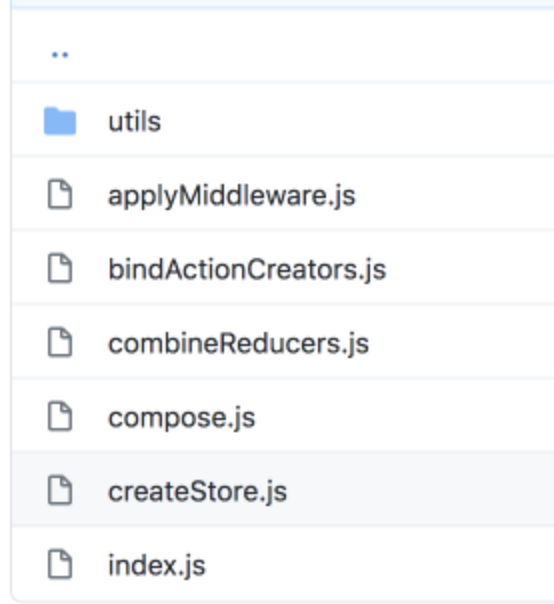
其中,utils 是工具方法库;index.js 作为入口文件,用于对功能模块进行收敛和导出。真正“干活”的是功能模块本身,也就是下面这几个文件:
applyMiddleware.js是中间件模块,它的独立性较强bindActionCreators.js用于将传入的actionCreator与dispatch方法相结合,揉成一个新的方法combineReducers.js用于将多个reducer合并起来compose.js用于把接收到的函数从右向左进行组合createStore.jscreateStore方法是我们在使用Redux时最先调用的方法,它是整个流程的入口,也是 Redux 中最核心的 API。理解Redux实现原理,真正需要我们关注的模块其实只有一个——createStore
故事的开始:createStore
使用 Redux 的第一步,我们就需要调用 createStore 方法。单纯从使用感上来说,这个方法做的事情似乎就是创建一个 store 对象出来,像这样:
// 引入 redux
import { createStore } from 'redux'
// 创建 store
const store = createStore(
reducer,
initial_state,
applyMiddleware(middleware1, middleware2, ...)
);
createStore方法可以接收以下 3 个入参:
reducer- 初始状态内容
- 指定中间件
从拿到入参到返回出 store 的过程中,到底都发生了什么呢?这里我为你提取了 createStore中主体逻辑的源码(解析在注释里)
function createStore(reducer, preloadedState, enhancer) {
// 这里处理的是没有设定初始状态的情况,也就是第一个参数和第二个参数都传 function 的情况
if (typeof preloadedState === 'function' && typeof enhancer === 'undefined') {
// 此时第二个参数会被认为是 enhancer(中间件)
enhancer = preloadedState;
preloadedState = undefined;
}
// 当 enhancer 不为空时,便会将原来的 createStore 作为参数传入到 enhancer 中
if (typeof enhancer !== 'undefined') {
return enhancer(createStore)(reducer, preloadedState);
}
// 记录当前的 reducer,因为 replaceReducer 会修改 reducer 的内容
let currentReducer = reducer;
// 记录当前的 state
let currentState = preloadedState;
// 声明 listeners 数组,这个数组用于记录在 subscribe 中订阅的事件
let currentListeners = [];
// nextListeners 是 currentListeners 的快照
let nextListeners = currentListeners;
// 该变量用于记录当前是否正在进行 dispatch
let isDispatching = false
// 该方法用于确认快照是 currentListeners 的副本,而不是 currentListeners 本身
function ensureCanMutateNextListeners() {
if (nextListeners === currentListeners) {
nextListeners = currentListeners.slice();
}
}
// 我们通过调用 getState 来获取当前的状态
function getState() {
return currentState;
}
// subscribe 订阅方法,它将会定义 dispatch 最后执行的 listeners 数组的内容
function subscribe(listener) {
// 校验 listener 的类型
if (typeof listener !== 'function') {
throw new Error('Expected the listener to be a function.')
}
// 禁止在 reducer 中调用 subscribe
if (isDispatching) {
throw new Error(
'You may not call store.subscribe() while the reducer is executing. ' +
'If you would like to be notified after the store has been updated, subscribe from a ' +
'component and invoke store.getState() in the callback to access the latest state. ' +
'See https://redux.js.org/api-reference/store#subscribe(listener) for more details.'
)
}
// 该变量用于防止调用多次 unsubscribe 函数
let isSubscribed = true;
// 确保 nextListeners 与 currentListeners 不指向同一个引用
ensureCanMutateNextListeners();
// 注册监听函数
nextListeners.push(listener);
// 返回取消订阅当前 listener 的方法
return function unsubscribe() {
if (!isSubscribed) {
return;
}
isSubscribed = false;
ensureCanMutateNextListeners();
const index = nextListeners.indexOf(listener);
// 将当前的 listener 从 nextListeners 数组中删除
nextListeners.splice(index, 1);
};
}
// 定义 dispatch 方法,用于派发 action
function dispatch(action) {
// 校验 action 的数据格式是否合法
if (!isPlainObject(action)) {
throw new Error(
'Actions must be plain objects. ' +
'Use custom middleware for async actions.'
)
}
// 约束 action 中必须有 type 属性作为 action 的唯一标识
if (typeof action.type === 'undefined') {
throw new Error(
'Actions may not have an undefined "type" property. ' +
'Have you misspelled a constant?'
)
}
// 若当前已经位于 dispatch 的流程中,则不允许再度发起 dispatch(禁止套娃)
if (isDispatching) {
throw new Error('Reducers may not dispatch actions.')
}
try {
// 执行 reducer 前,先"上锁",标记当前已经存在 dispatch 执行流程
isDispatching = true
// 调用 reducer,计算新的 state
currentState = currentReducer(currentState, action)
} finally {
// 执行结束后,把"锁"打开,允许再次进行 dispatch
isDispatching = false
}
// 触发订阅
const listeners = (currentListeners = nextListeners);
for (let i = 0; i < listeners.length; i++) {
const listener = listeners[i];
listener();
}
return action;
}
// replaceReducer 可以更改当前的 reducer
function replaceReducer(nextReducer) {
currentReducer = nextReducer;
dispatch({ type: ActionTypes.REPLACE });
return store;
}
// 初始化 state,当派发一个 type 为 ActionTypes.INIT 的 action,每个 reducer 都会返回
// 它的初始值
dispatch({ type: ActionTypes.INIT });
// observable 方法可以忽略,它在 redux 内部使用,开发者一般不会直接接触
function observable() {
// observable 方法的实现
}
// 将定义的方法包裹在 store 对象里返回
return {
dispatch,
subscribe,
getState,
replaceReducer,
[$$observable]: observable
}
}
通过阅读源码会发现,createStore 从外面看只是一个简单的创建动作,但在内部却别有洞天,涵盖了所有 Redux 主流程中核心方法的定义
接下来我将 createStore 内部逻辑总结进一张大图中,这张图涵盖了每个核心方法的工作内容,它将帮助你快速把握 createStore 的逻辑框架。
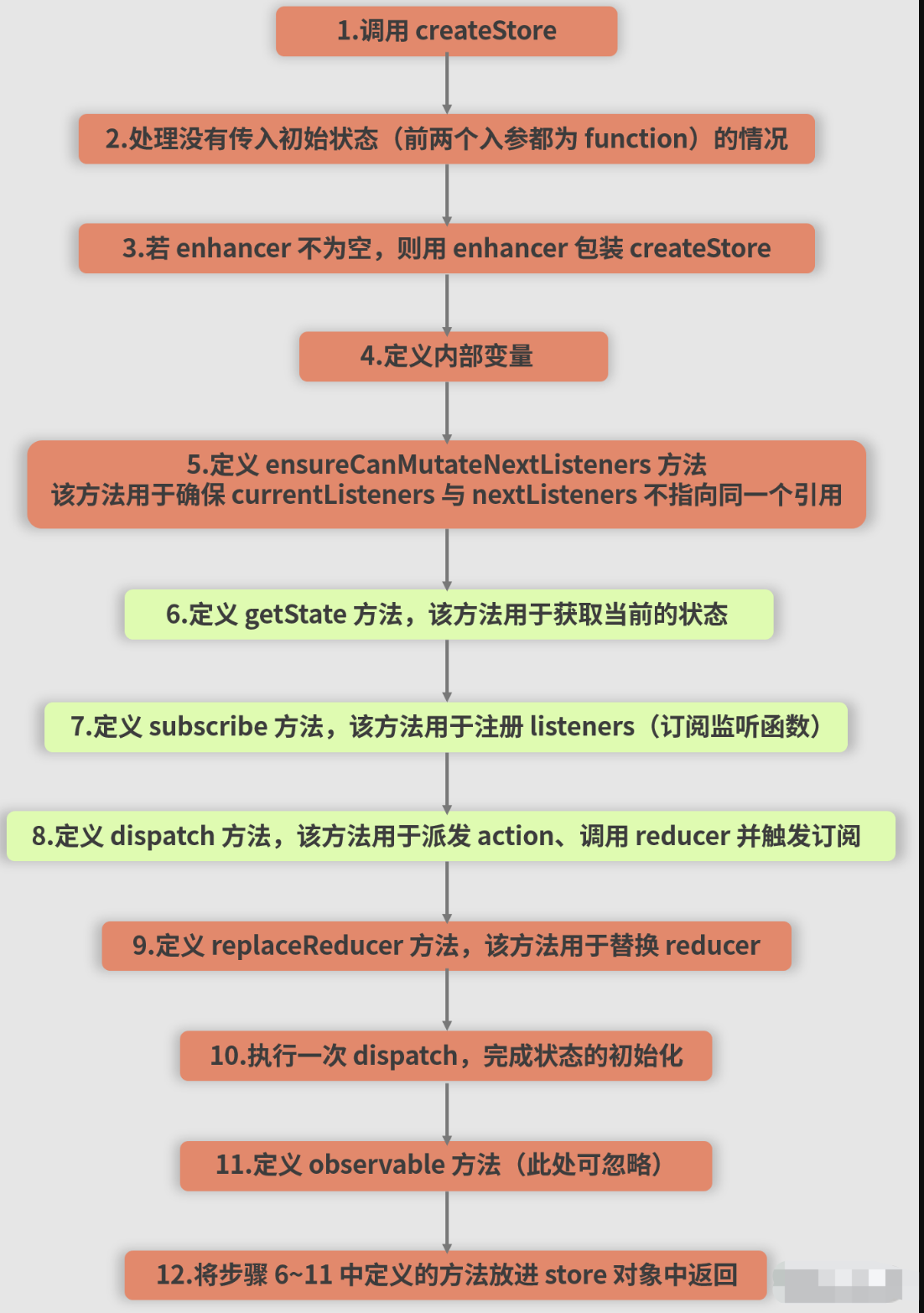
在 createStore 导出的方法中,与 Redux 主流程强相关的,同时也是我们平时使用中最常打交道的几个方法,分别是
getStatesubscribedispatch
Redux 工作流的核心:dispatch 动作
dispatch 应该是大家在使用 Redux 的过程中最为熟悉的 API 了。结合前面对设计思想的解读,我们已经知道,在 Redux 中有这样 3 个关键要素:
actionreducerstore
之所以说 dispatch 是 Redux 工作流的核心,是因为dispatch 这个动作刚好能把 action、reducer和 store 这三位“主角”给串联起来。dispatch 的内部逻辑,足以反映了这三者之间“打配合”的过程。
function dispatch(action) {
// 校验 action 的数据格式是否合法
if (!isPlainObject(action)) {
throw new Error(
'Actions must be plain objects. ' +
'Use custom middleware for async actions.'
)
}
// 约束 action 中必须有 type 属性作为 action 的唯一标识
if (typeof action.type === 'undefined') {
throw new Error(
'Actions may not have an undefined "type" property. ' +
'Have you misspelled a constant?'
)
}
// 若当前已经位于 dispatch 的流程中,则不允许再度发起 dispatch(禁止套娃)
if (isDispatching) {
throw new Error('Reducers may not dispatch actions.')
}
try {
// 执行 reducer 前,先"上锁",标记当前已经存在 dispatch 执行流程
isDispatching = true
// 调用 reducer,计算新的 state
currentState = currentReducer(currentState, action)
} finally {
// 执行结束后,把"锁"打开,允许再次进行 dispatch
isDispatching = false
}
// 触发订阅
const listeners = (currentListeners = nextListeners);
for (let i = 0; i < listeners.length; i++) {
const listener = listeners[i];
listener();
}
return action;
}
这里我结合源码,帮大家将 dispatch 的工作流程提取如下:
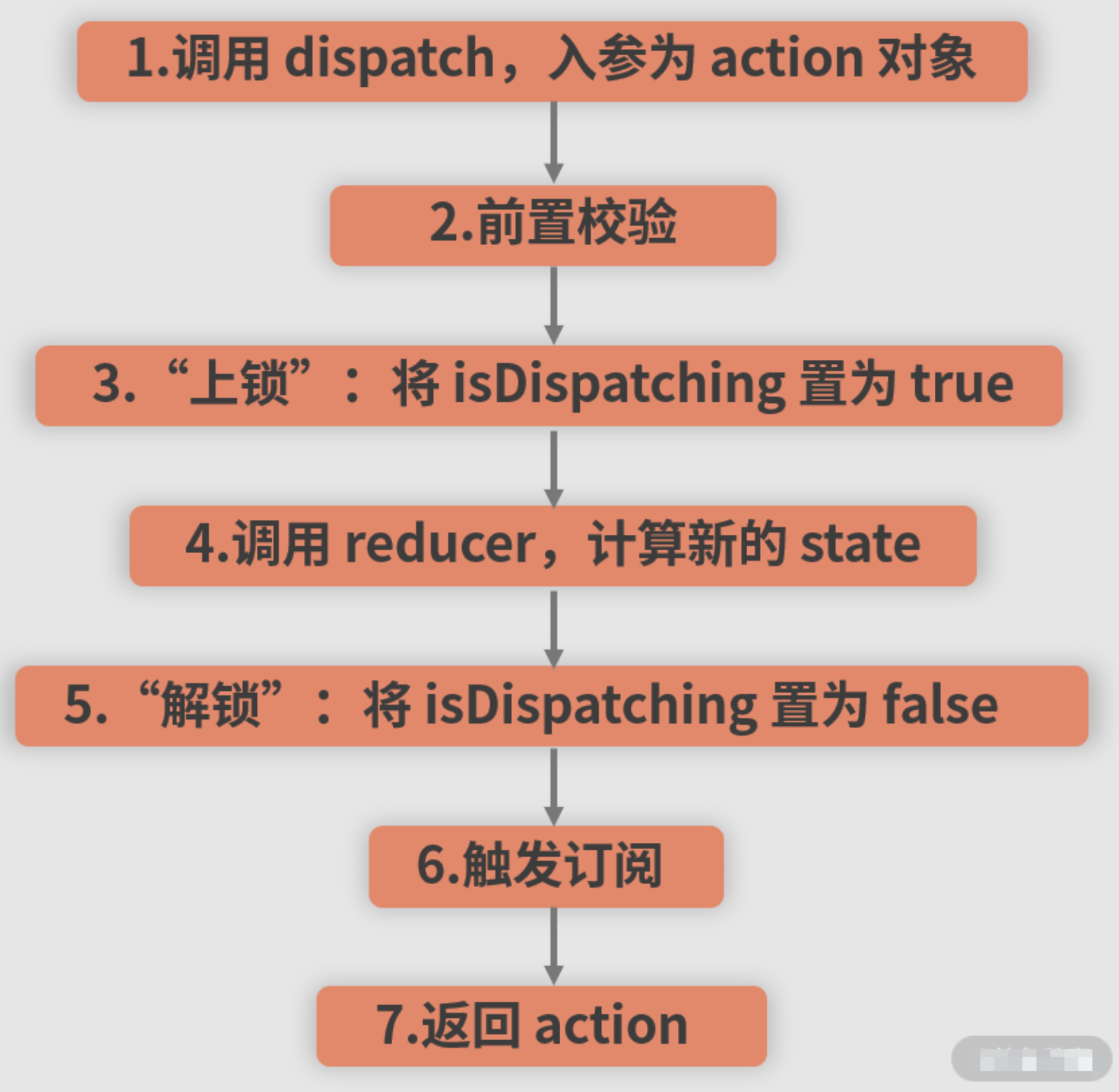
1. 通过“上锁”避免“套娃式”的 dispatch
dispatch 工作流中最关键的就是执行 reducer 这一步,它对应的是下面这段代码:
try {
// 执行 reducer 前,先“上锁”,标记当前已经存在 dispatch 执行流程
isDispatching = true
// 调用 reducer,计算新的 state
currentState = currentReducer(currentState, action)
} finally {
// 执行结束后,把"锁"打开,允许再次进行 dispatch
isDispatching = false
}
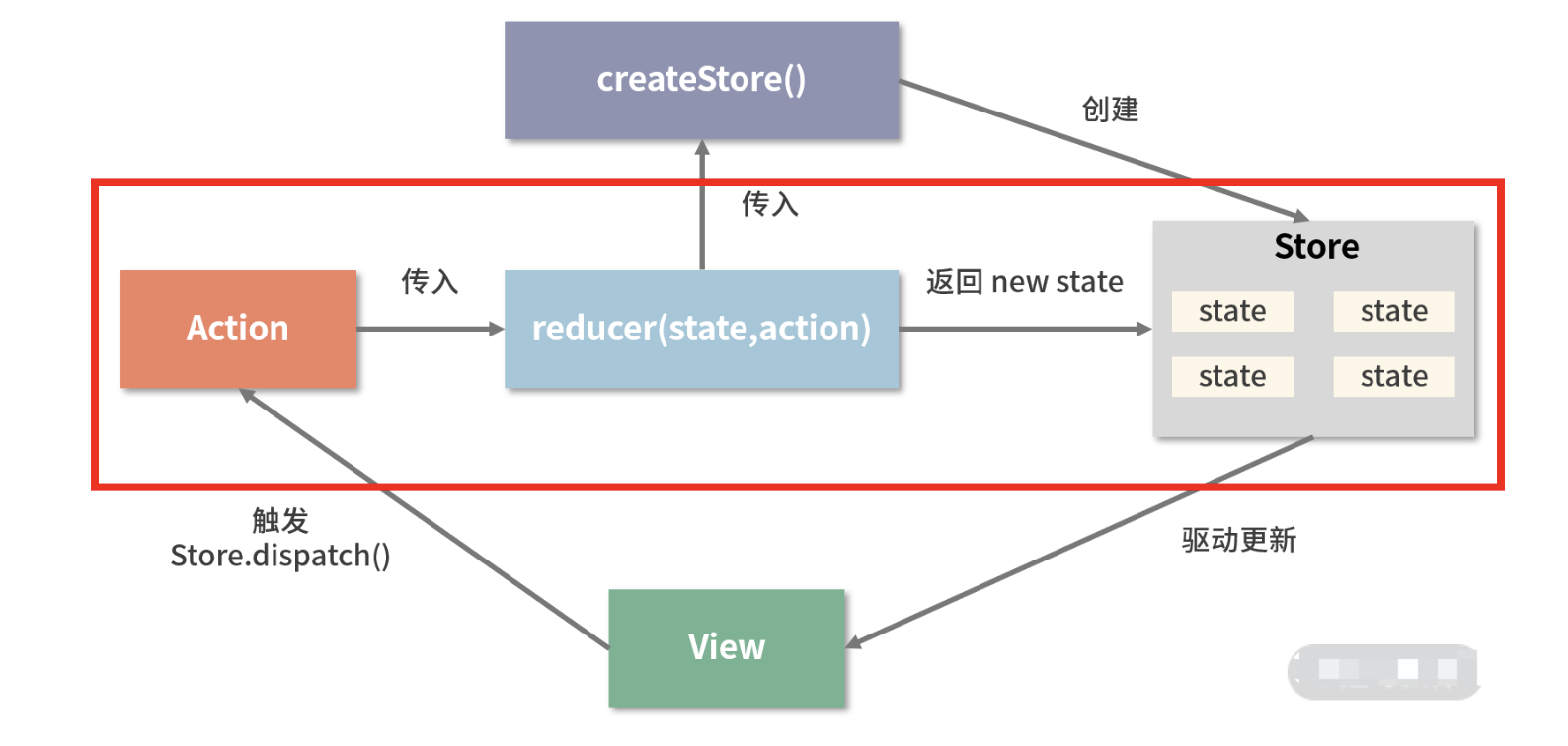
在调用 reducer 之前,Redux 首先会将 isDispatching 变量置为 true,待 reducer 执行完毕后,再将 isDispatching 变量置为 false
这里之所以要用 isDispatching 将 dispatch 的过程锁起来,目的是规避“套娃式”的 dispatch。更准确地说,是为了避免开发者在 reducer 中手动调用 dispatch。
若真的在 reducer 中调用 dispatch,那么 dispatch 又会反过来调用 reducer,reducer 又会再次调用 dispatch......这样反复相互调用下去,就会进入死循环,属于非常严重的误操作。
因此,在 dispatch 的前置校验逻辑中,一旦识别出 isDispatching 为 true,就会直接 throw Error(见下面代码),把死循环扼杀在摇篮里:
if (isDispatching) {
throw new Error('Reducers may not dispatch actions.')
}
2. 触发订阅的过程
在 reducer 执行完毕后,会进入触发订阅的过程,它对应的是下面这段代码:
// 触发订阅
const listeners = (currentListeners = nextListeners);
for (let i = 0; i < listeners.length; i++) {
const listener = listeners[i];
listener();
}
Redux 中的“发布-订阅”模式:认识 subscribe
dispatch 中执行的 listeners 数组从订阅中来,而执行订阅需要调用
subscribe。在实际的开发中,subscribe并不是一个严格必要的方法,只有在需要监听状态的变化时,我们才会调用subscribe
subscribe 接收一个 Function 类型的 listener 作为入参,它的返回内容恰恰就是这个 listener 对应的解绑函数。你可以通过下面这段示例代码简单把握一下 subscribe 的使用姿势:
function handleChange() {
// 函数逻辑
}
const unsubscribe = store.subscribe(handleChange)
unsubscribe()
subscribe 在订阅时只需要传入监听函数,而不需要传入事件类型。这是因为 Redux 中已经默认了订阅的对象就是“状态的变化(准确地说是 dispatch 函数的调用)”这个事件。
subscribe 是如何与 Redux 主流程结合的呢?首先,我们可以在 store 对象创建成功后,
通过调用 store.subscribe 来注册监听函数,也可以通过调用 subscribe 的返回函数来解绑监听函数,监听函数是用 listeners 数组来维护的;当dispatch action 发生时,Redux 会在 reducer 执行完毕后,将 listeners 数组中的监听函数逐个执行。这就是 subscribe 与 Redux 主流程之间的关系。
接下来我们结合源码来分析一下 subscribe 的内部逻辑,subscribe 源码提取如下:
function subscribe(listener) {
// 校验 listener 的类型
if (typeof listener !== 'function') {
throw new Error('Expected the listener to be a function.')
}
// 禁止在 reducer 中调用 subscribe
if (isDispatching) {
throw new Error(
'You may not call store.subscribe() while the reducer is executing. ' +
'If you would like to be notified after the store has been updated, subscribe from a ' +
'component and invoke store.getState() in the callback to access the latest state. ' +
'See https://redux.js.org/api-reference/store#subscribe(listener) for more details.'
)
}
// 该变量用于防止调用多次 unsubscribe 函数
let isSubscribed = true;
// 确保 nextListeners 与 currentListeners 不指向同一个引用
ensureCanMutateNextListeners();
// 注册监听函数
nextListeners.push(listener);
// 返回取消订阅当前 listener 的方法
return function unsubscribe() {
if (!isSubscribed) {
return;
}
isSubscribed = false;
ensureCanMutateNextListeners();
const index = nextListeners.indexOf(listener);
// 将当前的 listener 从 nextListeners 数组中删除
nextListeners.splice(index, 1);
};
}
结合这段源码,我们可以将 subscribe 的工作流程提取如下:
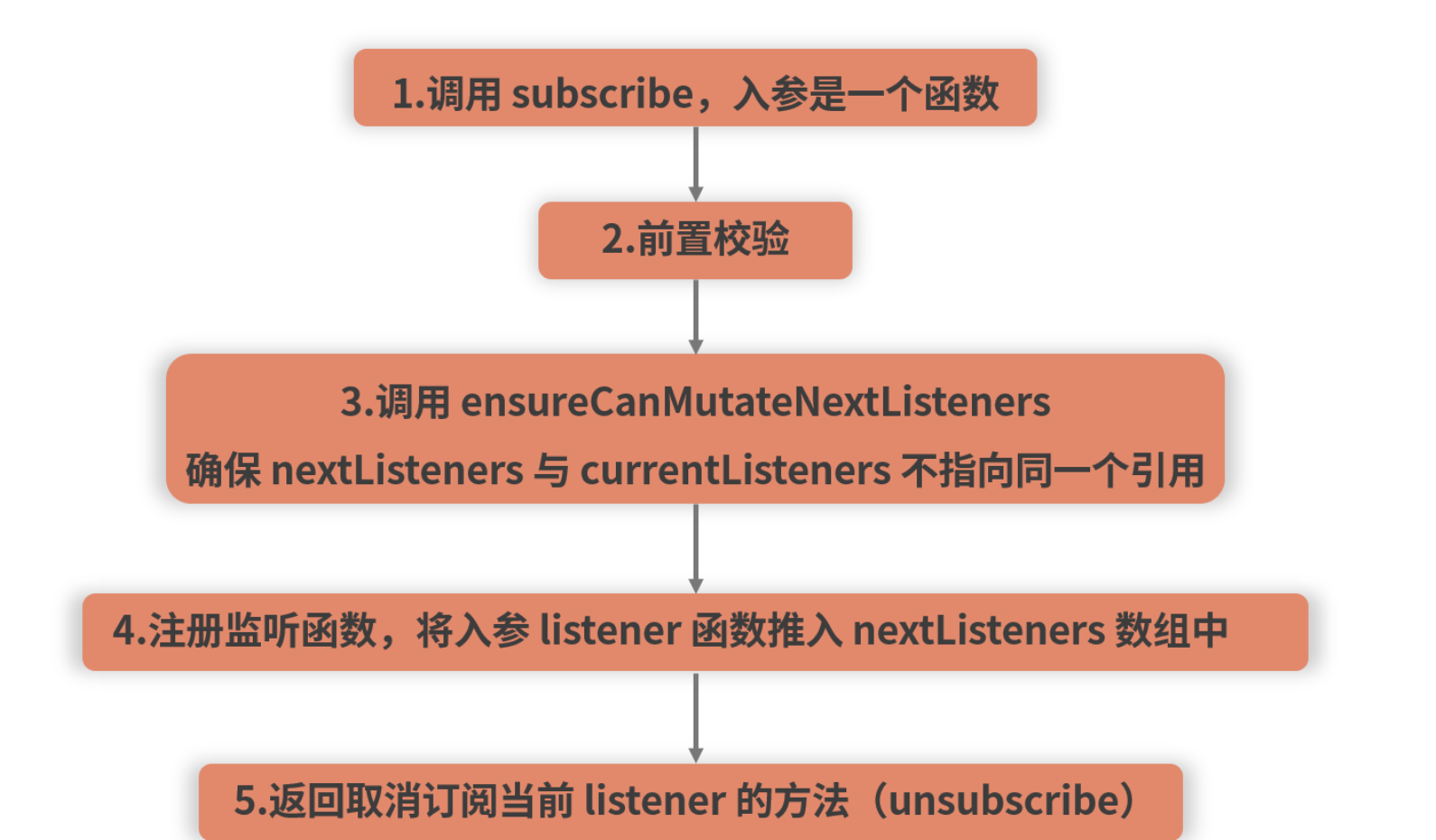
1. 订阅过程中的 listeners 数组
两个 listeners 之间的第一次“交锋”发生在 createStore 的变量初始化阶段,nextListeners 会被赋值为 currentListeners(见下面代码),这之后两者确实指向同一个引用。
let nextListeners = currentListeners
但在 subscribe 第一次被调用时,ensureCanMutateNextListeners 就会发现这一点,然后将 nextListeners 纠正为一个内容与 currentListeners 一致、但引用不同的新对象。对应的逻辑如下面代码所示:
function ensureCanMutateNextListeners() {
// 若两个数组指向同一个引用
if (nextListeners === currentListeners) {
// 则将 nextListeners 纠正为一个内容与 currentListeners 一致、但引用不同的新对象
nextListeners = currentListeners.slice()
}
}
在 subscribe 的逻辑中,ensureCanMutateNextListeners 每次都会在 listener 注册前被无条件调用,用以确保两个数组引用不同。紧跟在 ensureCanMutateNextListeners 之后执行的是 listener 的注册逻辑,我们可以对应源码中看到 listener 最终会被注册到 nextListeners 数组中去:
nextListeners.push(listener);
2. 发布过程中的 listeners 数组
触发订阅这个动作是由 dispatch 来做的,相关的源码如下:
// 触发订阅
const listeners = (currentListeners = nextListeners);
for (let i = 0; i < listeners.length; i++) {
const listener = listeners[i];
listener();
}
这段源码告诉我们,在触发订阅的过程中,currentListeners 会被赋值为 nextListeners,而实际被执行的 listeners 数组又会被赋值为 currentListeners。因此,最终被执行的 listeners 数组,实际上和当前的 nextListeners 指向同一个引用。
这就有点奇妙了:注册监听也是操作 nextListeners,触发订阅也是读取 nextListeners(实际上,细心的同学会注意到,取消监听操作的也是 nextListeners 数组)。既然如此,要 currentListeners 有何用?
3. currentListeners 数组用于确保监听函数执行过程的稳定性
正因为任何变更都是在 nextListeners 上发生的,我们才需要一个不会被变更的、内容稳定的 currentListeners ,来确保监听函数在执行过程中不会出幺蛾子。
举个例子,下面这种操作在 Redux 中完全是合法的:
// 定义监听函数 A
function listenerA() {
}
// 订阅 A,并获取 A 的解绑函数
const unSubscribeA = store.subscribe(listenerA)
// 定义监听函数 B
function listenerB() {
// 在 B 中解绑 A
unSubscribeA()
}
// 定义监听函数 C
function listenerC() {
}
// 订阅 B
store.subscribe(listenerB)
// 订阅 C
store.subscribe(listenerC)
在这个 Demo 执行完毕后,nextListeners 数组的内容是 A、B、C 3 个 listener:
[listenerA, listenerB, listenerC]
接下来若调用 dispatch,则会执行下面这段触发订阅的逻辑:
// 触发订阅
const listeners = (currentListeners = nextListeners);
for (let i = 0; i < listeners.length; i++) {
const listener = listeners[i];
listener();
}
当 for 循环执行到索引 i = 1 处,也就是对应的 listener 为 listenerB 时,问题就会出现:listenerB 中执行了 unSubscribeA 这个动作。而结合我们前面的分析,监听函数注册、解绑、触发这些动作实际影响的都是 nextListeners。为了强化对这一点的认知,我们来复习一下 unsubscribe 的源码:
return function unsubscribe() {
// 避免多次解绑
if (!isSubscribed) {
return;
}
isSubscribed = false;
// 熟悉的操作,调用 ensureCanMutateNextListeners 方法
ensureCanMutateNextListeners();
// 获取 listener 在 nextListeners 中的索引
const index = nextListeners.indexOf(listener);
// 将当前的 listener 从 nextListeners 数组中删除
nextListeners.splice(index, 1);
};
假如说不存在 currentListeners,那么也就意味着不需要 ensureCanMutateNextListeners 这个动作。若没有 ensureCanMutateNextListeners,unsubscribeA() 执行完之后,listenerA 会同时从 listeners 数组和 nextListeners 数组中消失(因为两者指向的是同一个引用),那么 listeners 数组此时只剩下两个元素 listenerB 和 listenerC,变成这样:
[listenerB, listenerC]
listeners 数组的长度改变了,但 for 循环却不会感知这一点,它将无情地继续循环下去。之前执行到 i = 1 处,listener = listeners[1] ,也就是说 listener === listenerB;下一步理应执行到 i = 2 处,但此时 listeners[2] 已经是 undefined 了,原本应该出现在这个索引位上的 listenerC,此时因为数组长度的变化,被前置到了 i = 1 处!这样一来,undefined 就会代替 listenerC 被执行,进而引发函数异常。
这可怎么办呢?答案当然是将 nextListeners 与当前正在执行中的 listeners 剥离开来,将两者指向不同的引用。这也正是 ensureCanMutateNextListeners 所做的事情。
在示例的这种场景下,ensureCanMutateNextListeners 执行前,listeners、currentListeners 和 nextListeners 之间的关系是这样的:
listeners === currentListeners === nextListeners
而 ensureCanMutateNextListeners 执行后,nextListeners 就会被剥离出去:
nextListeners = currentListeners.slice()
listeners === currentListeners !== nextListeners
这样一来,nextListeners 上的任何改变,都无法再影响正在执行中的 listeners 了。currentListeners 在此处的作用,就是为了记录下当前正在工作中的 listeners 数组的引用,将它与可能发生改变的 nextListeners 区分开来,以确保监听函数在执行过程中的稳定性。
阅读全文
